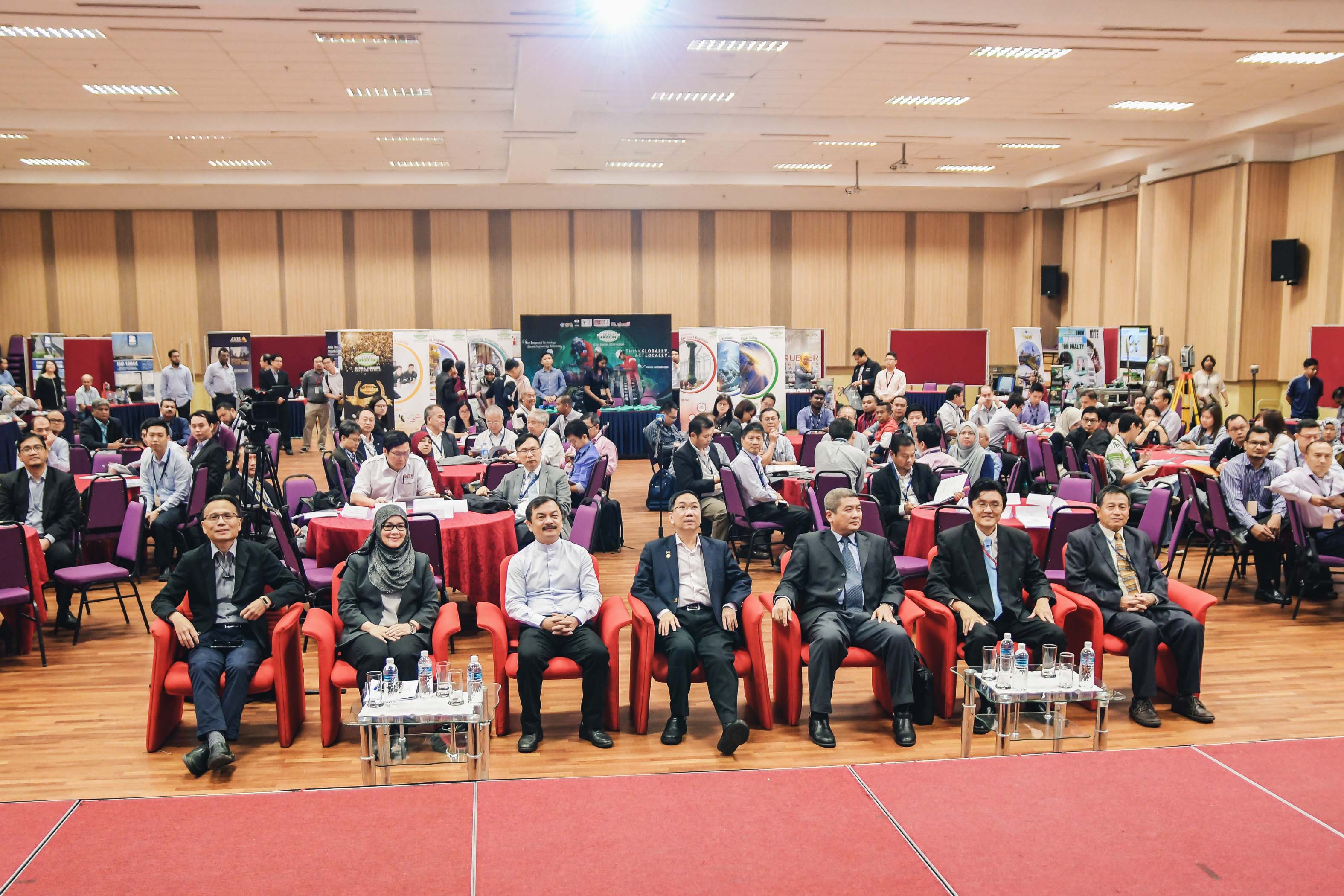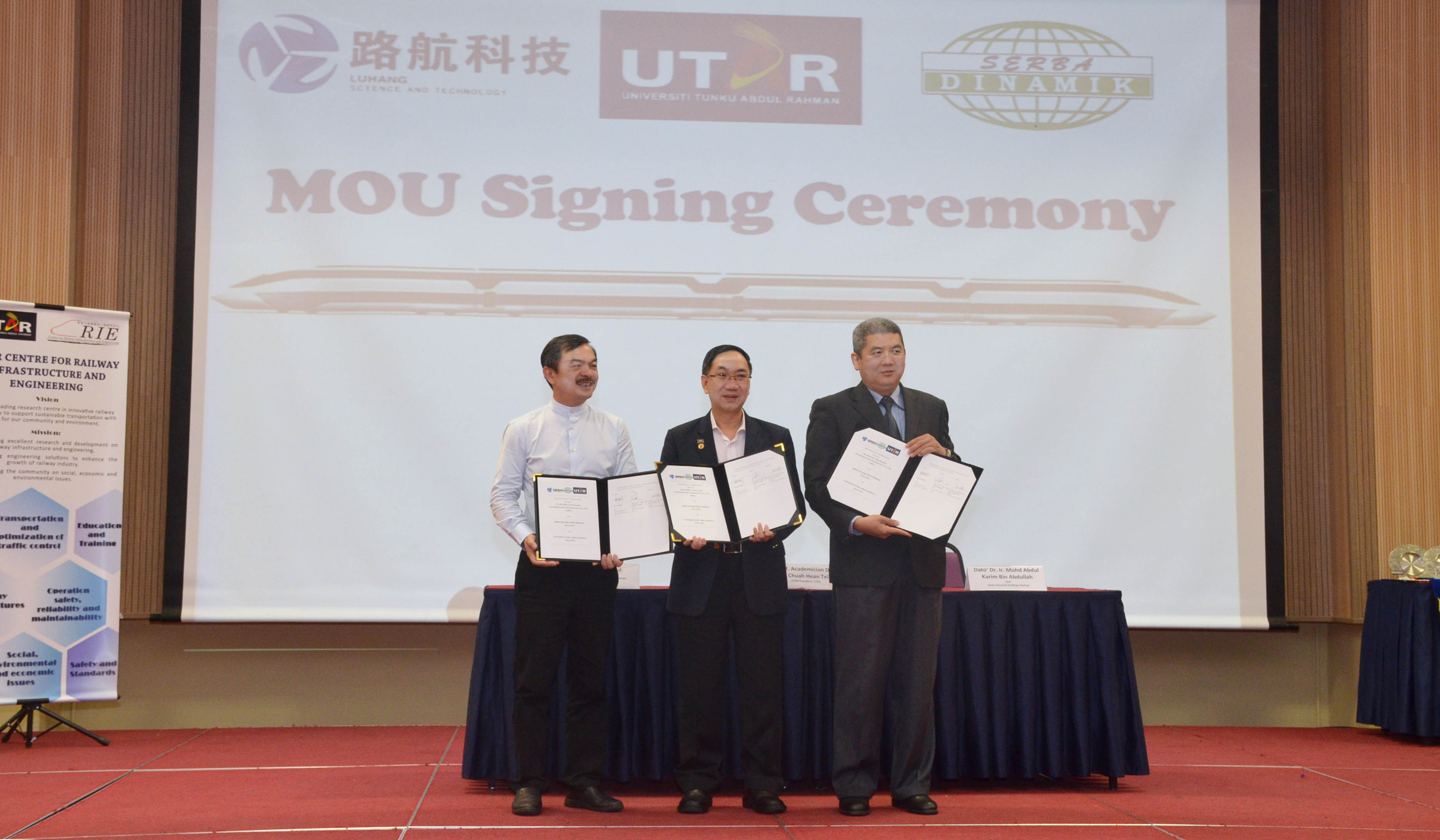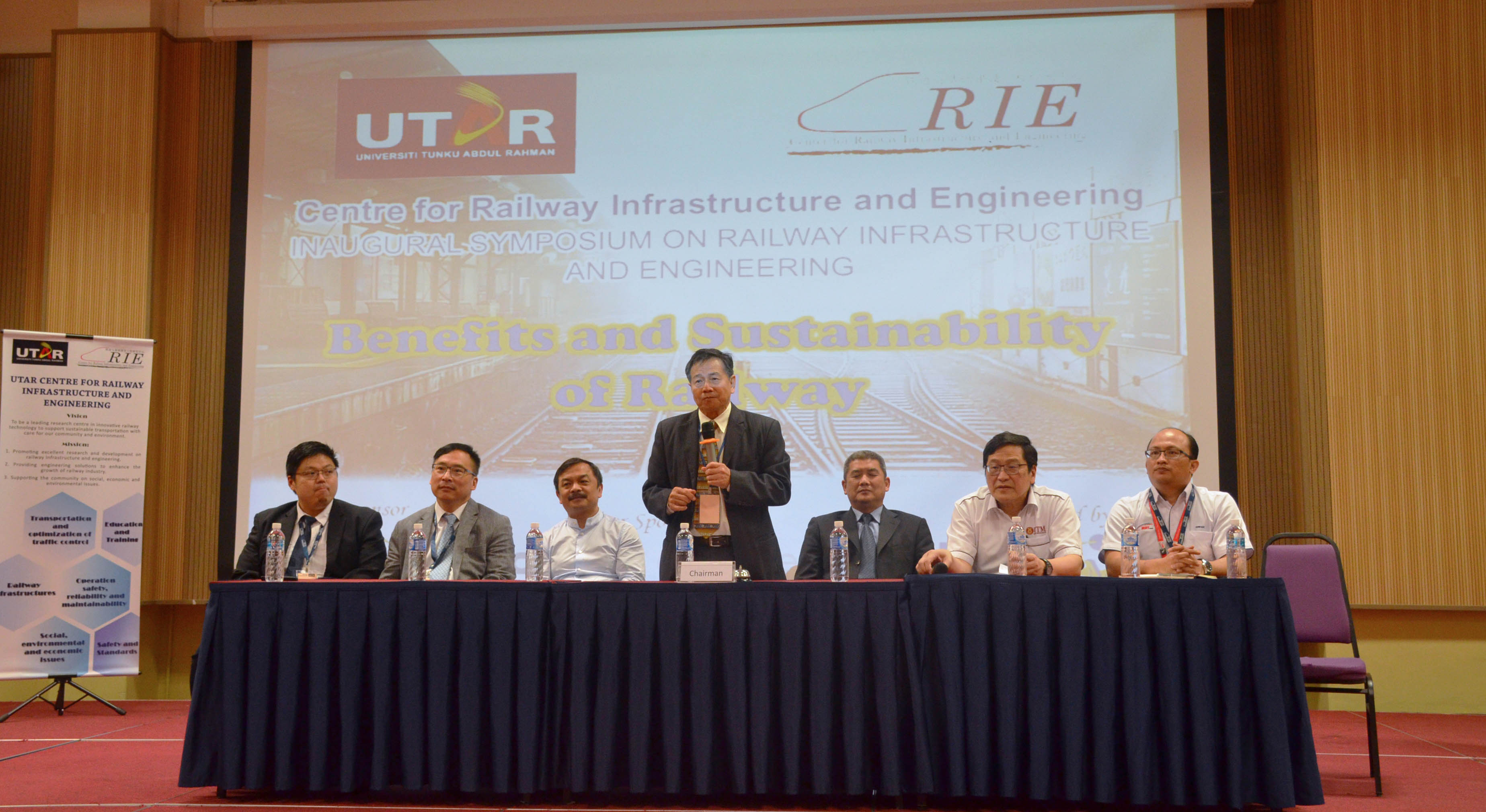

The inaugural symposium saw more than 170 participants
UTAR Centre for Railway Infrastructure and Engineering (CRIE) organised the inaugural Symposium on Railway Infrastructure and Engineering on 24 January 2018 at the UTAR Sungai Long Campus.
Present at the symposium were UTAR President Ir Prof Academician Dato’ Dr Chuah Hean Teik, Serba Dinamik Group Berhad President Dato’ Dr Ir M. A. Karim Abdullah, Prasarana Malaysia Berhad President and Group Chief Executive Officer Masnizam Hisham, UTAR Vice President Prof Ir Dr Lee Sze Wei, UTAR Lee Kong Chian Faculty of Engineering and Science Dean Prof Ir Dr Goi Bok Min, and symposium Chair-cum-CRIE Chairperson Prof Dr Andy Chit Tan, as well as speakers from local and foreign universities, and the industry. The symposium saw more than 170 participants.

A MoU was signed among UTAR, Serba Dinamik Sdn Bhd and Luhang Rail Transportation Technology Co. Ltd by (from left) Prof Lin, Prof Chuah and Dato’ Abdul Karim
In conjunction with the symposium, a memorandum of understanding (MoU) was signed among UTAR, Serba Dinamik Sdn Bhd and Luhang Rail Transportation Technology Co. Ltd, Changzhou, China to promote research, training, education and innovation in railway. The event also saw the launch of the new research centre, UTAR - Centre for Railway Infrastructure and Engineering, with its initial founding members, Southwest Jiaotong University, Serba Dinamik Sdn Bhd and Doshin Rubber Sdn Bhd.
Prof Andy remarked, “The one-day symposium was set to congregate practitioners, owners, operators, researchers and academics to share and promote research activities of the railway industry. It also aimed to support the new initiatives of expanding the rail network in Malaysia and China’s One Belt One Road initiative in the region. Besides, the symposium also served as a networking platform to encourage the exchange of ideas among researchers, universities, practitioners and owners from various expertise. Among the areas of expertise included railway infrastructures; safety and standards; operation safety, reliability and maintainability; social, environmental and economic issues; education and training; and transportation and optimisation of traffic control.”
On behalf of UTAR, Prof Chuah welcomed the guests and the participants. He said, “The spinoff of rail network expansion into education is expected to carry great momentum. With its expansion and educational opportunities, it is timely for the University to establish a research centre to promote interdisciplinary research in various areas such as railway infrastructure, engineering and socio-economics, education, training and services. I am glad that our initiative has been well received by the industry. I would like to thank the sponsors, exhibitors and supporters for your support and commitment. I would also like to urge the engineers who are also the consumers to contribute to the field of railway.”
Themed ‘Benefits and Sustainability of Railway’, the symposium
encompassed two keynote addresses, two sessions of invited presentations
and a forum.

From left: Dato’ Abdul Karim and Prasarana President Masnizam were the keynote speakers for the inaugural symposium
The first keynote speaker was Dato’ Abdul Karim who spoke on “Rail Traction Technology Getting Momentum in Malaysia”. He emphasised, “All the developments, constructions and maintenance activities in the rail industry will require governance by a central agency to address many issues. Hence, it is necessary for the Malaysian government, industry players and academics to work together to strengthen our capabilities and competitiveness in the rail technology and eco-system.”
On the other hand, the second keynote speaker, Prasarana President Masnizam spoke on “Pursuing Operations Excellence”. She highlighted on the milestones achieved by Prasarana since 2015 and some of the organisation’s present and future plans. She said, “In view of the many developments and projects that will be carried out in the foreseeable future, we need more talents to join the workforce and contribute to the field. Therefore, we need support from the universities to train more skilful graduates to help improve the operations of the whole system.”
The keynote addresses were followed by the first session of invited presentations. It was chaired by Assoc Prof Dr Rahizar Ramli from Universiti Malaya. It commenced with the speech by Luhang Rail Transportation Technology Co. Ltd Deputy General Manager Luo Wencheng on behalf of Southwest Jiaotong University Traction Power State Key Laboratory and Changzhou Institute of Rail Transport Director Prof Lin Jianhui on “Health Monitoring and Early Warning of High-speed Rail Based on Vibration and Temperature”. The subsequent speaker was Mass Rapid Transit Corporation Sdn Bhd GIS Manager Aswadi Yusof who spoke on “Building Information Modelling and Geographic Information System in Mega Construction Project – A Sharing from Klang Valley Mass Rapid Transit Sungai Buloh-Serdang-Putrajaya Line Project”.
Chaired by Aswadi Yusof, the second session consisted of three presentations. It began with a lecture by the Director of The Smart Engineering Asset Management Laboratory and Croucher Optical Nondestructive Testing Laboratory, Prof Peter Tse Wei Tat. He spoke on “Novel Techniques in Guided Wave for Performing Quality Inspection on Building Pipes and Train Rails.” It was followed by Doshin Rubber Engineering Products (M) Sdn Bhd Dr Patrick Tiong who presented on behalf of his Director Or Tan Teng on “Rubber as an Excellent Engineering Material for Vibration and Seismic Control in Civil Engineering Structures”. Also speaking at the symposium was Universiti Teknologi Malaysia Institute of Noise and Vibration HiCoE Director Prof Mohd Salman Leong. He presented on “Noise and Vibration Environmental Impact in Malaysian Railway Schemes – Issues and Mitigation from Past and Current Lines”.
The symposium forum was chaired by Prof Andy, with the panel consisting of the invited speakers for a panel discussion. The symposium adjourned with closing remarks by Dato’ Abdul Karim. He said, “The symposium has provided a platform for the experts, researchers, government sectors, industry and academia to interact and keep them abreast of the latest information in this area. I hope the future symposium could be held at an international level to allow broader exchanges and learning opportunities.”

The forum was chaired by Prof Andy (middle) with the invited speakers
In view of China’s One Belt One Road initiative which encompasses South East Asia, Asia and nations all the way to Europe is already drawing enormous attention in the region and abroad. The connectivity and cooperation between those countries will be a major step forward in terms of trade, cultural and scientific exchanges in the new century. Meanwhile, in Malaysia, the government is embarking on this new initiative and is expanding its rail network throughout the country. The introduction of the first MRT line in the Klang Valley and the commencement of the East Coast Rail Link are examples of the Government’s plan to continue the improvement of the transportation network. Besides, agreements have been established to develop the high speed rail (HSR) from Singapore to Peninsular Malaysia.
As such, an opportunity arose for UTAR to establish a research centre to promote interdisciplinary research in railway infrastructure, engineering and socio-economics, and railway engineering related courses and services. It will serve the ongoing rail transport services in Malaysia as well as the new ECRL and MRT.
The inaugural Symposium on Railway Infrastructure and Engineering was supported by the Institute of Engineers, Malaysia (IEM) and Institute of Materials, Malaysia (IMM). It was sponsored by Serba Dinamik, Doshin Rubber and Getzner.
Click here for more photos of the exhibitors and speakers.
© 2019 UNIVERSITI TUNKU ABDUL RAHMAN DU012(A).
Wholly owned by UTAR Education Foundation Co. No. 578227-M LEGAL STATEMENT TERM OF USAGE PRIVACY NOTICE